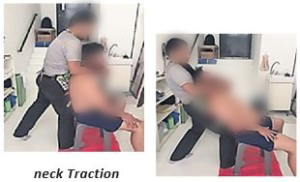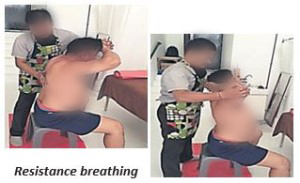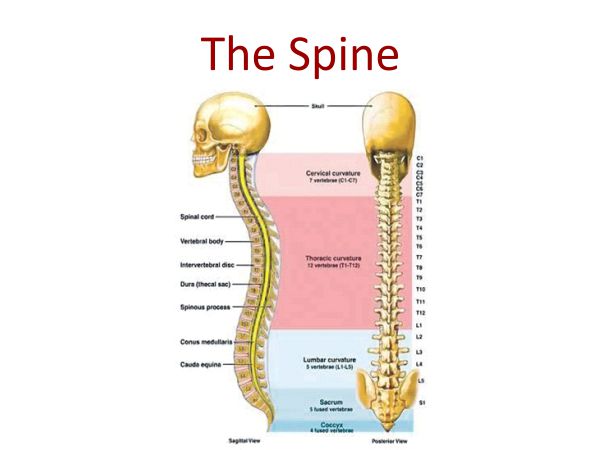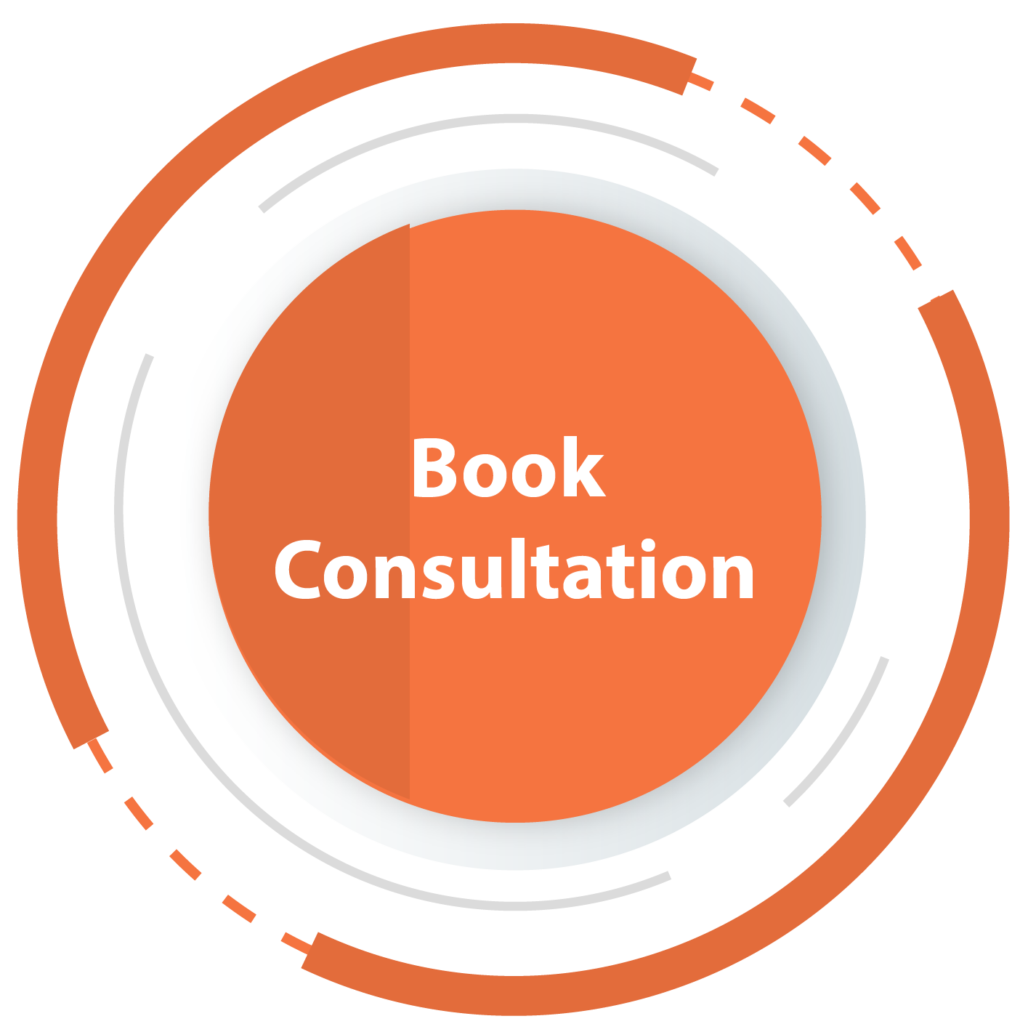Spine
The spine / back is a complex structure and one of the most important components of the body which is made up of 33 individual bones (known as vertebra) stacked one on top of each other. These are supported and connected together by ligaments, tendons and muscles, giving them the stability and flexibility it needs to function, enabling you to stand, move, bend and twist. Together they form part of the ‘spinal system’. It also provides strong protection to the spinal cord, a highway of nerves connecting your body and your brain.
The spine has natural curves that form an S-shape. The neck (cervical) and low back (lumbar) regions have a slight concave curve, and the thoracic and sacral regions have a gentle convex curve. The curves work like a coiled spring to absorb shock, maintain balance and allow range of motion throughout the spinal column.
The 33 bones are divided into 5 areas:
1. Cervical Spine
7 vertebraes (C1–C7), running from the stem of the brain down the neck
2. Thoracic Spine
12 vertebraes (T1–T12), region of the upper & middle back
3. Lumbar Spine:
5 vertebraes (L1–L5), starting from below the shoulder blades down to the abdomen.
4. Sacral Spine
5 fused vertebraes (sacrum), found in the lower back and extends to the tailbone
5. Coccygeal Spine
4 fused vertebraes (coccyx), the very bottom section of then spine
Each vertebra in the spine is a bone made up of:
- A main body known as the vertebral body.
- Pedicles of bone coming from both sides and the back of the body which in turn forms joints with their neighbouring vertebra.
- A disc which lies in between each vertebral body, acting as a cushion between the bones.
Backpain
Back pain is a very common complaint which we will all experience at least once in our lives. Even though back pain can affect people of any age, it is significantly more common among adults aged between 35 and 55 years. Back pain is associated with the way our bones, muscles and ligaments in our backs work and connect together. Back pain includes lower back pain, middle back pain, upper back pain or low back pain with sciatica. Nerve and muscular problems, degenerative disc Issuesand arthritis too can result in back pain.
The anatomic classification of back pain follows the segments of the spine: neck pain (cervical), middle back pain (thoracic), lower back pain (lumbar) or coccydynia (tailbone or sacral pain) with the lumbar vertebrae area most common for pain. The pain may originate from the muscles, nerves, bones, joints, ligaments, disk or other structures in the vertebral column (spine). Internal structures such as the gallbladder and pancreas may also cause referred pain in the back.
Pain in the lower back may be linked to the bony lumbar spine, discs between the vertebrae, ligaments around the spine and discs, spinal cord and nerves, lower back muscles, abdomen and pelvic internal organs, and the skin around the lumbar area. Pain in the upper back may be due to Issuess of the aorta, tumors in the chest and spine inflammation.
The spinal structures that cause problem to back / neck pain are:
- Discs, nerves, ligaments, bones and muscles.

Backpain Causes
The causes of back pain are numerous; some are self-inflicted due to a lifetime of bad habits. Other back pain causes include accidents, muscle strains, and sports injuries. Back pain can come on suddenly and last less than six weeks (acute), which may be caused by a fall or heavy lifting. Back pain that lasts more than three months (chronic) is less common than acute pain.
Complementory Therapy
Backpain complementary Management cannot be generalized as the pain differs from one person to another. Hence, the complementary Management prescribed depend on the patience conditions. complementary Management that can be prescribed are as follows:
- PPS , Pichu, UltraSonic
- Followed by Traction (performed after a few sessions of the other complementary Management)
Traction
What is spinal Traction?
The pain experienced by patients with neck and low back pain can sometimes be not only localized centrally in the neck or back, but can refer peripherally into the arm and hands or legs and feet. Also, weakness in an extremity related to the neck or back can be present. This can be due to spinal nerve root and peripheral nerve irritation or compression associated with a potential spinal disc injury or joint dysfunction. One very effective complementary Management is Spinal Traction.
Traction to correct spinal deformity is a very old concept. The oldest reference available is in ancient Hindu mythological epics (written between 3500 BC and 1800 BC) where it is mentioned how Lord Krishna corrected the hunchback of one of his devotees.
Spinal traction is a complementary Management technique performed by applying the longitudinal force to stretch and decompress the vertebral joints and soft tissues around the spine. It is most commonly used on the cervical and lumbar spines, as well as to the thoracic spine. Traction is applied with a specific grade of force or weight, and for a specific duration according to the signs and symptoms of the condition. For instance, traction can be applied from a range of a few seconds up to 30 minutes, depending on what is needed. The force or weight used is usually relatively low and feels quite comfortable to the patient.
Spinal traction is a form of decompression therapy that relieves pressure on the spine. It is a gentle pulling of the soft tissue (joints and muscles) to help straighten the spine, to reduce the curvature in the spines, stretches the spine to take pressure off compressed discs which helps and improves the body’s ability to heal itself. It can be performed manually or mechanically.
Spinal traction is used to manage:
- Herniated discs
- Sciatica, Degenerative disc disease
- Pinched nerves
- And many other back conditions
There are 2 methods of Traction:
This method is often used when a specific force and a longer duration of traction is needed.

Effects of Spinal Traction:
- Decrease compression forces and help distract vertebral bodies
- Help mobilize the facet joints in the spine; increase the space where the spinal nerves exit out of the spine and help decrease irritation of these nerves
- Enhance nourishment of the disc and nerve; and increase circulation
- Decrease muscle spasm as well as stretch the muscles and connective tissues along the spine
- Decrease the sensitivity and pain in the joints of the spine
- Spinal elongation and the flattening of curvature in the spin


- Seat patient on a chair and place a neck pillow underneath patient’s chin
- Therapist to stand behind patient and wraps arm around the front of patient’s neck
- Inhale to pull, exhale to release
- Repeat 5 rounds

- Resistance breathing
- Patient presses again hand and apply constant pressure for 4 breaths (left, right, front, back) 5 rounds
- Standing cobra breathing 5 rounds


- Lumbar stretches – 4 Breathes each side Folded, Crossed, Both, Side
- Ardha chakrasana –4 breath x 5 roundsCome to neutral at the end of each round
- Ardha Ustrasana –4 breath x 5 roundsCome to neutral at the end of each round.** Support can be from the front (in picture) or back. Patient’s hands can be on the hips for support.
- Deep Relaxation Technique (DRT) –Can be practiced in the following ways:– With folded legs– In Makarasana– Lying on the back with legs folded at the knees and supported by the wall
Subtle Point
- Longitudinal alignment should be maintained during traction
- Throat should not be compressed
Indication
- Cervical spondylosis
- Herniated discs
- Lumbar Spondylosis (most common -L5 slipping forward on S1,disc prolapse)
- Spondylitis ( inflammation)
- Spondylolisthesis ( disc slippage )
Contraindication
- Any Surgery
- Extreme Pain
- Fracture
Acknowledgement to:
- CYT / ATTC Students of Union Yoga Ayurveda Singapore
- Swami Vivekananda Yoga Prakashana Trust, Bangalore
Disclaimer
Yoga Ayurveda Therapy is Complementary Medicine and doesn't alternates any conventional treatment.
Yoga-Ayurveda Therapy needs physical assistance which may need physical touch. You can ask teacher or therapist not to give physical touch or assistance and based on whatever you choose, our teacher or therapist will follow the instructions. Any point you want to change the preference, then please inform teacher or therapist and management in writing. You will take responsibility of your decision and will not hold Union Yoga Ayurveda responsible for any kind of damage.
All kind of Yoga Ayurveda teaching and therapy can cause certain injuries and you are accepting those injuries. Signing up for the therapy or yoga courses means that you are aware of the probable injuries.
Union Yoga Ayurveda (Union Centre Pte Ltd) and its staff are not liable or responsible for any injuries caused during the session which are visible or not visible, physical or hormonal or mental. You as client take full responsibility of your own decision and will not claim any kind of compensation in terms of money or any resources for the damage caused because of due process.
Related Topics
- Yoga Therapy & Common Ailments
- Diabetes Mellitus
- Yoga & Glaucoma
- Chronic Myeloid Leukemia
- Gastro-Esophageal Reflux / Gastritis
- High Blood Pressure
- For Anxiety neurosis, Depressions etc
- For Neurological issues
- Cataract and short / long Sightedness
- Scoliosis / Herneated disc / Sciatica
- Menstrual Issues


